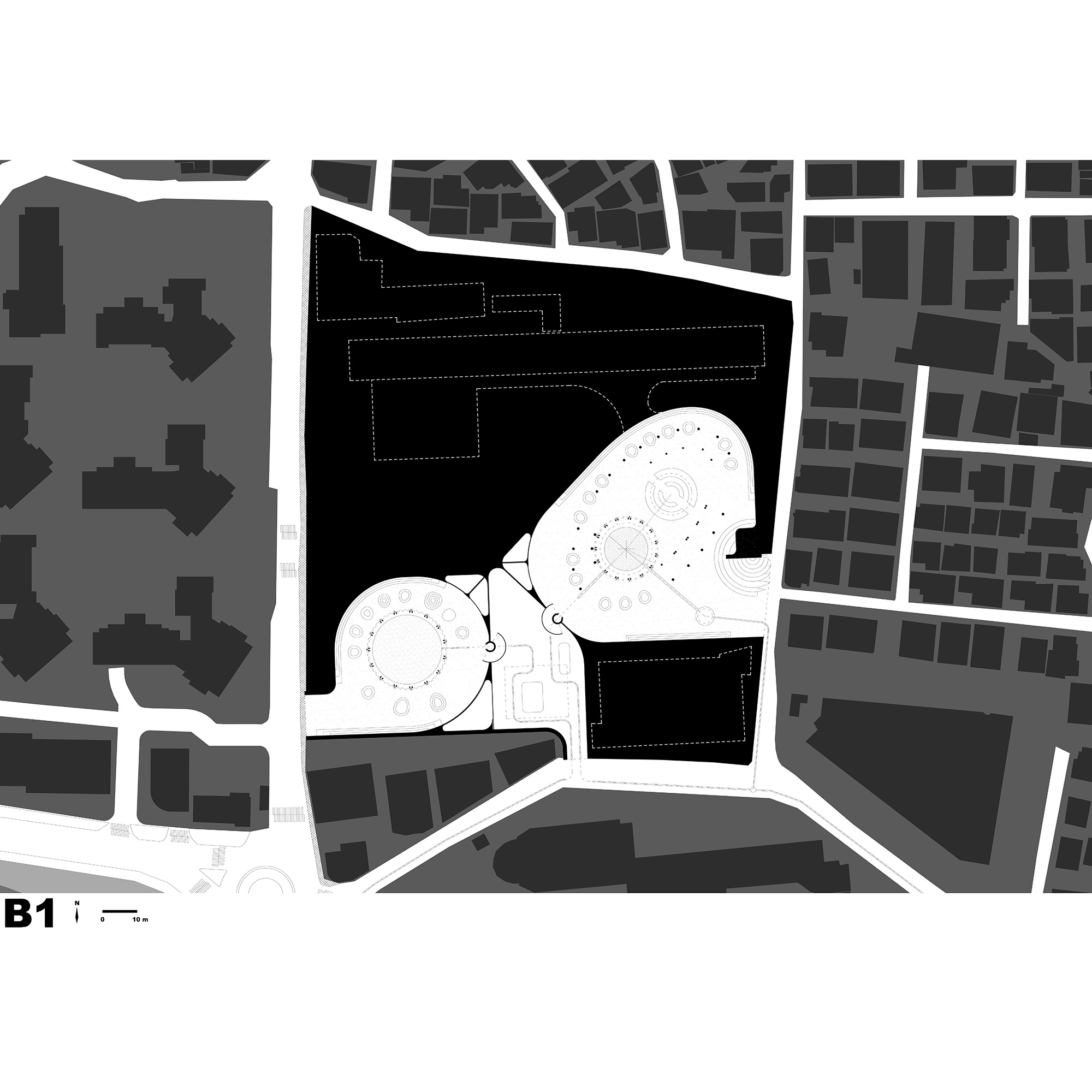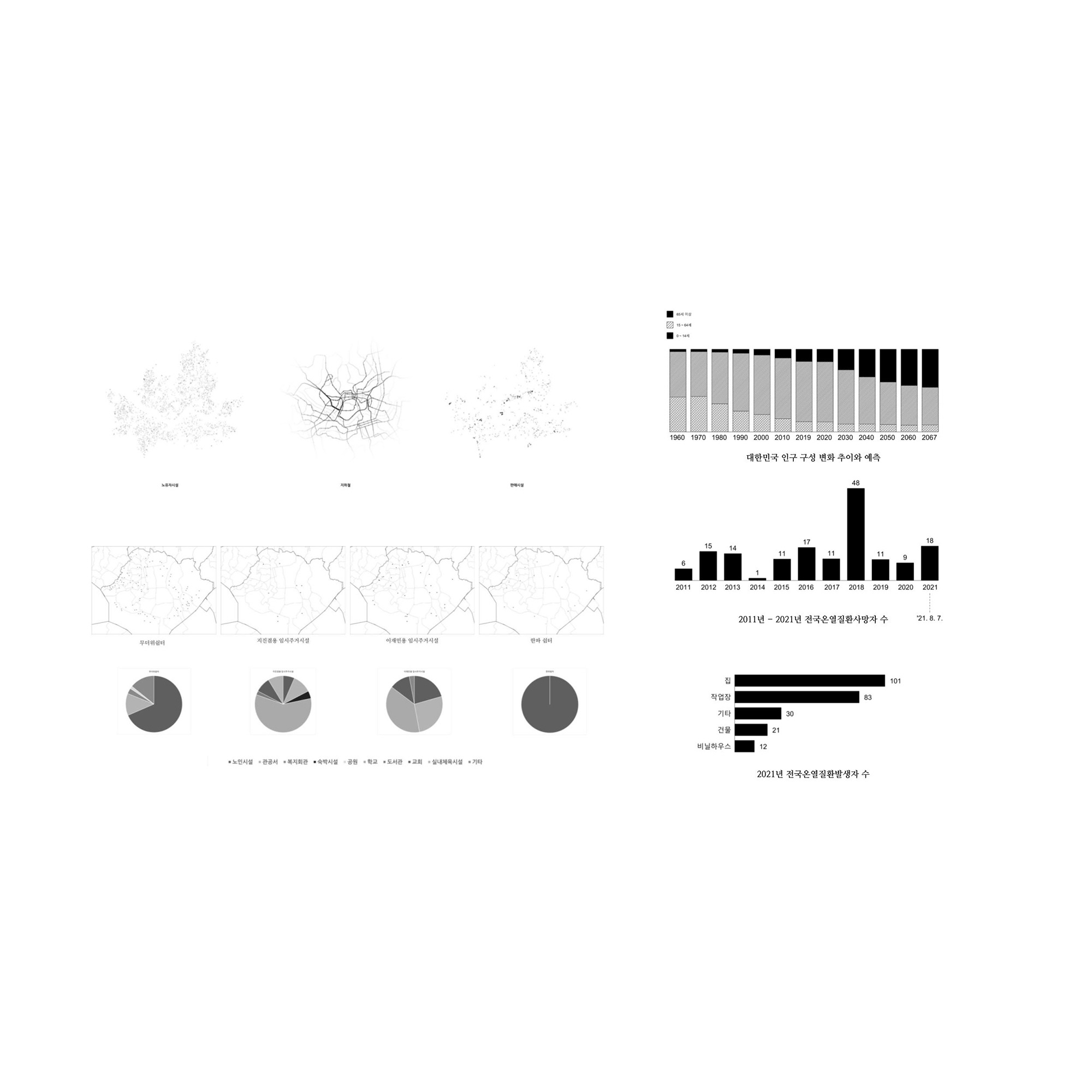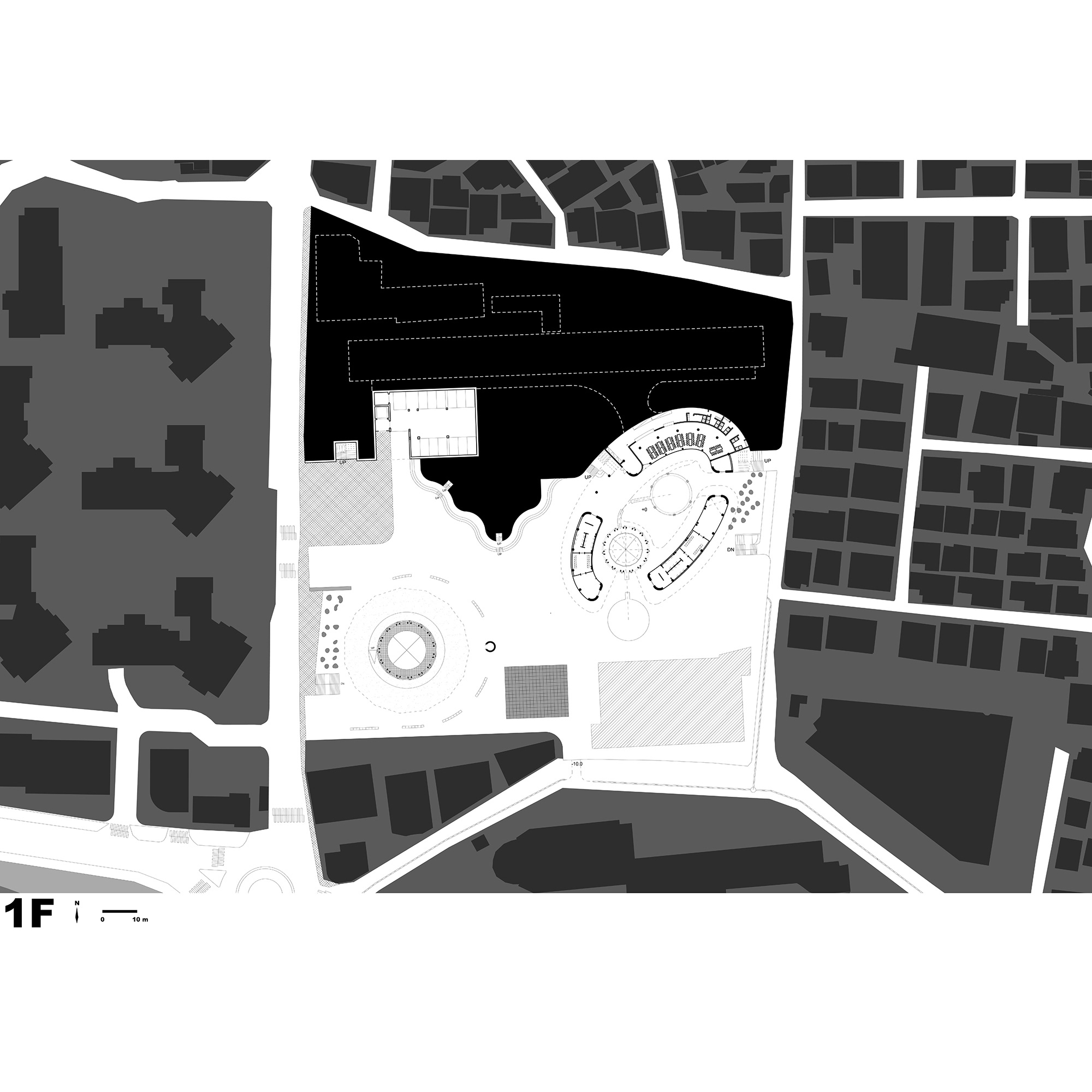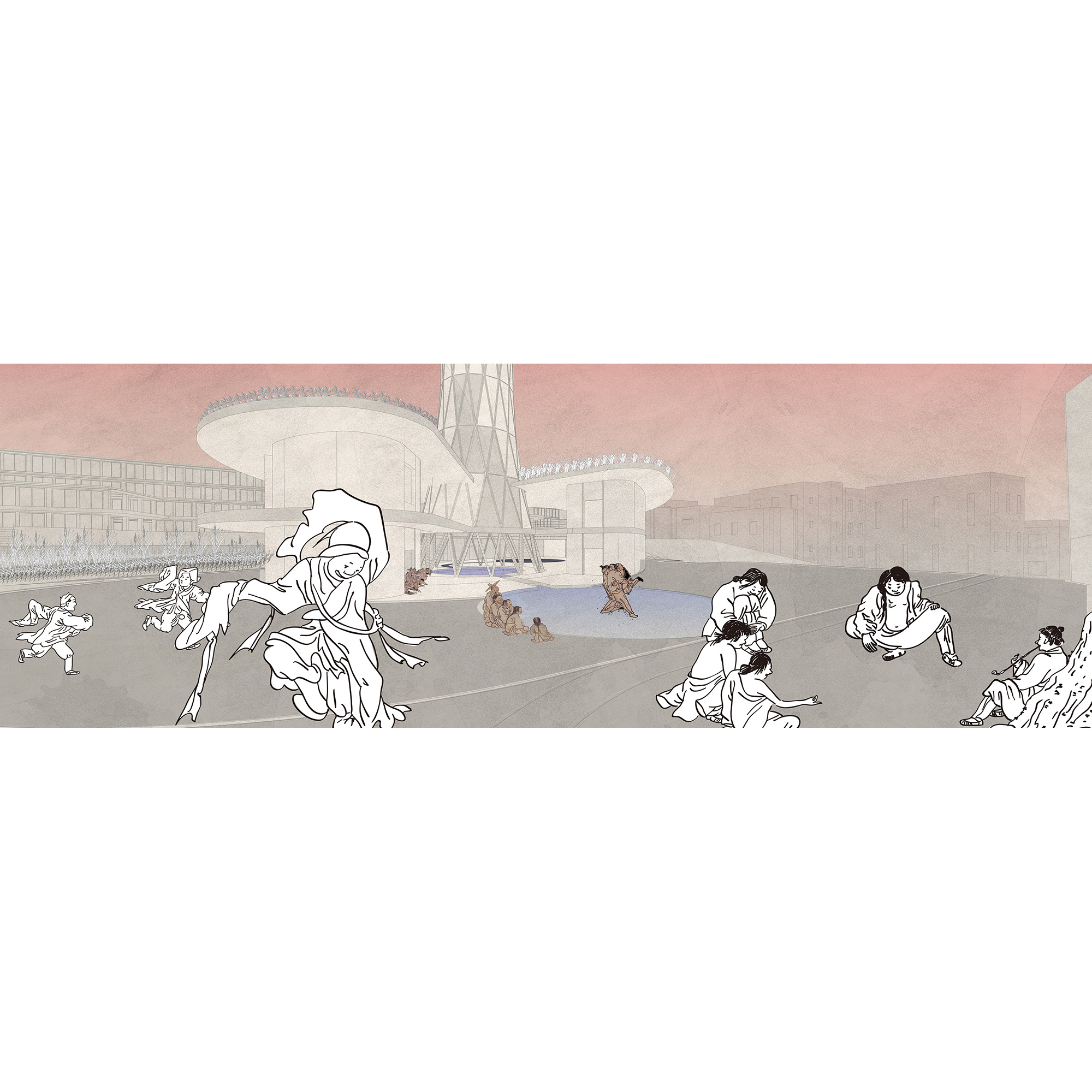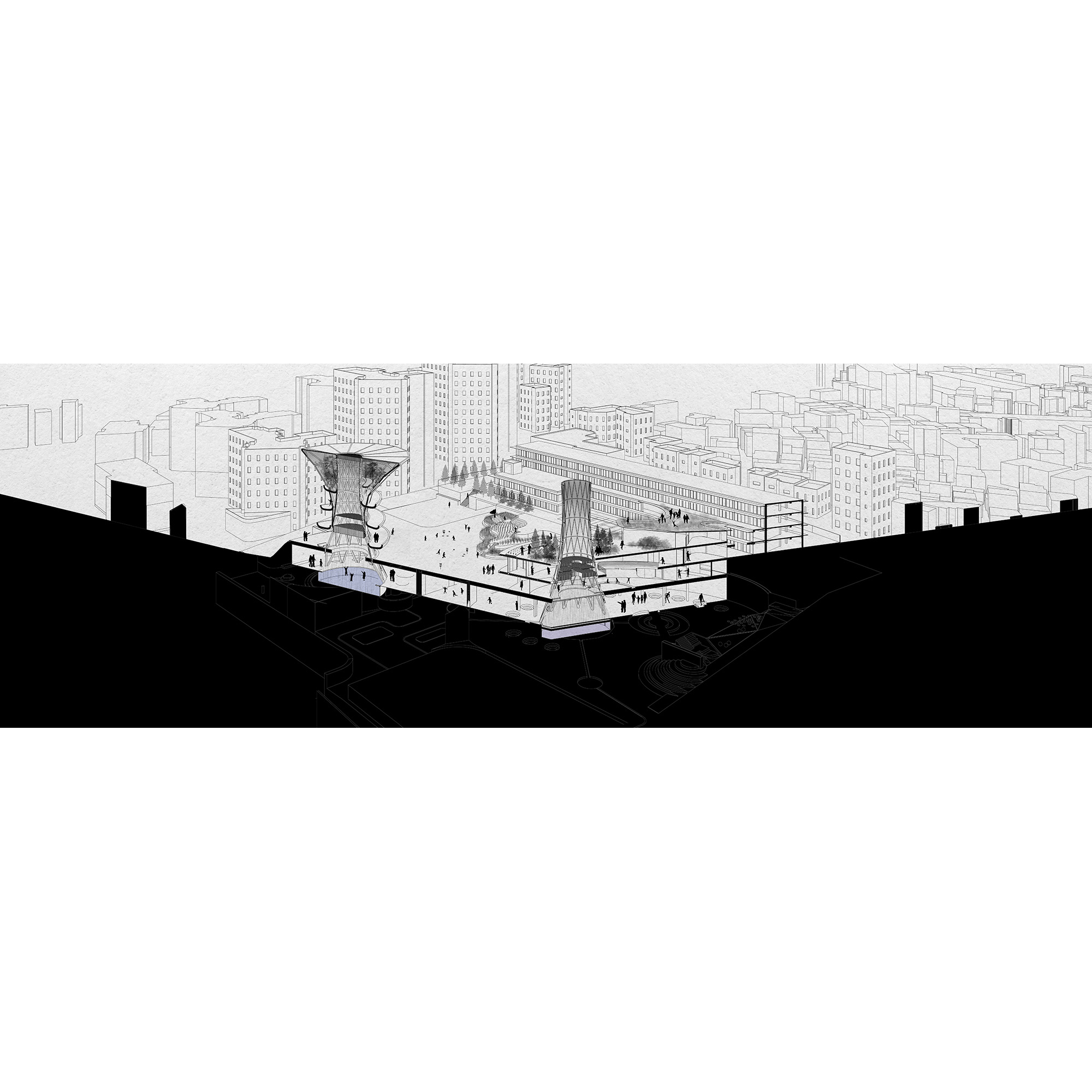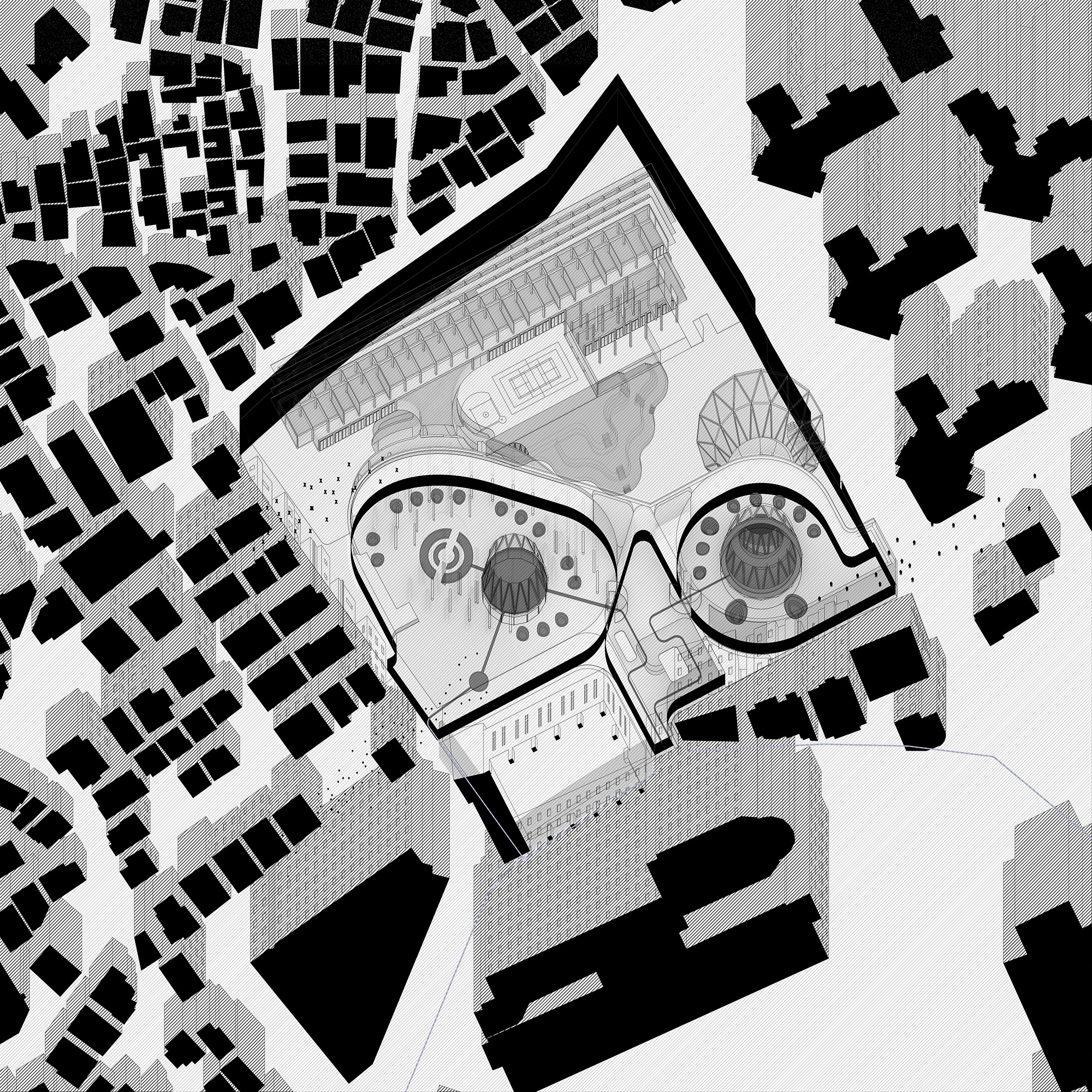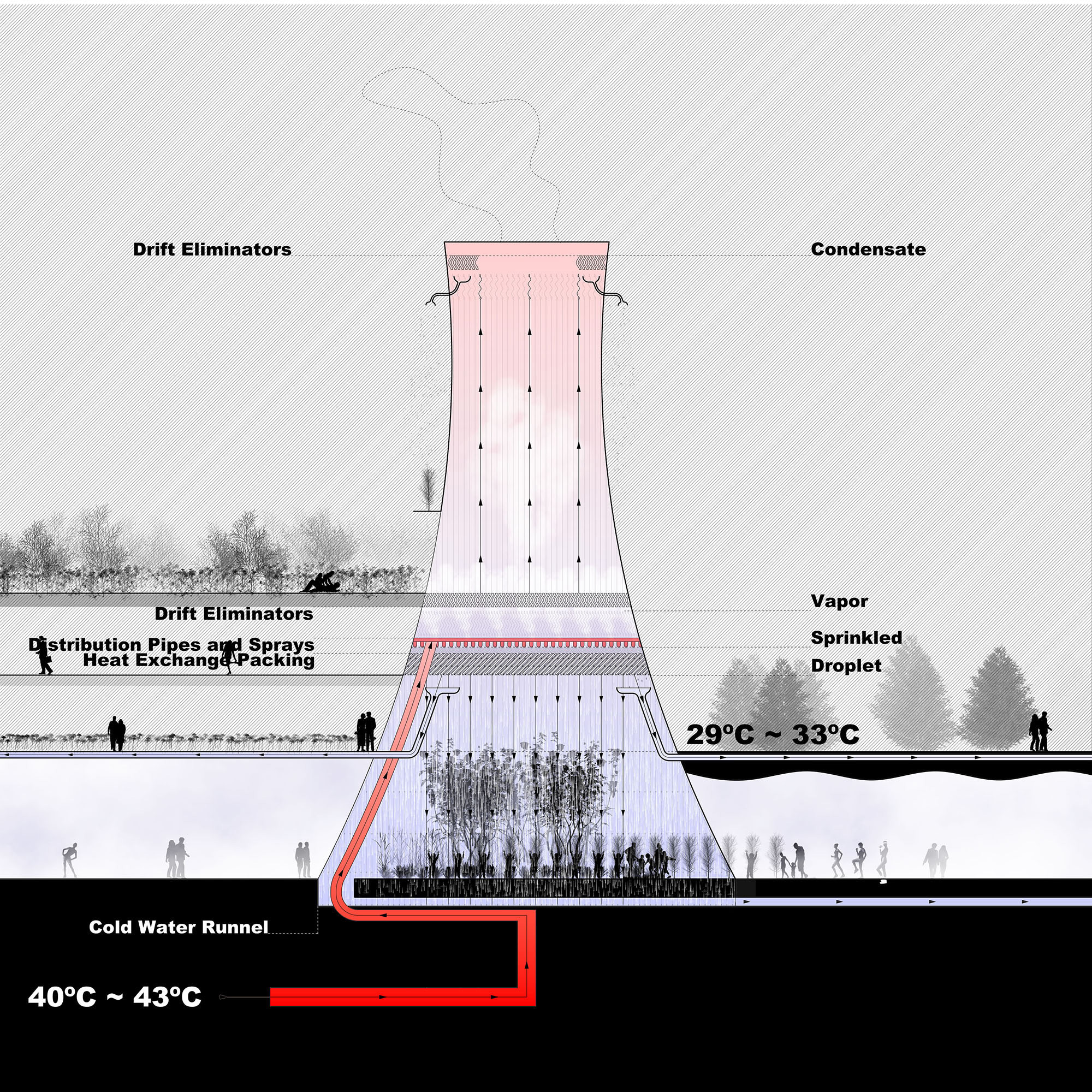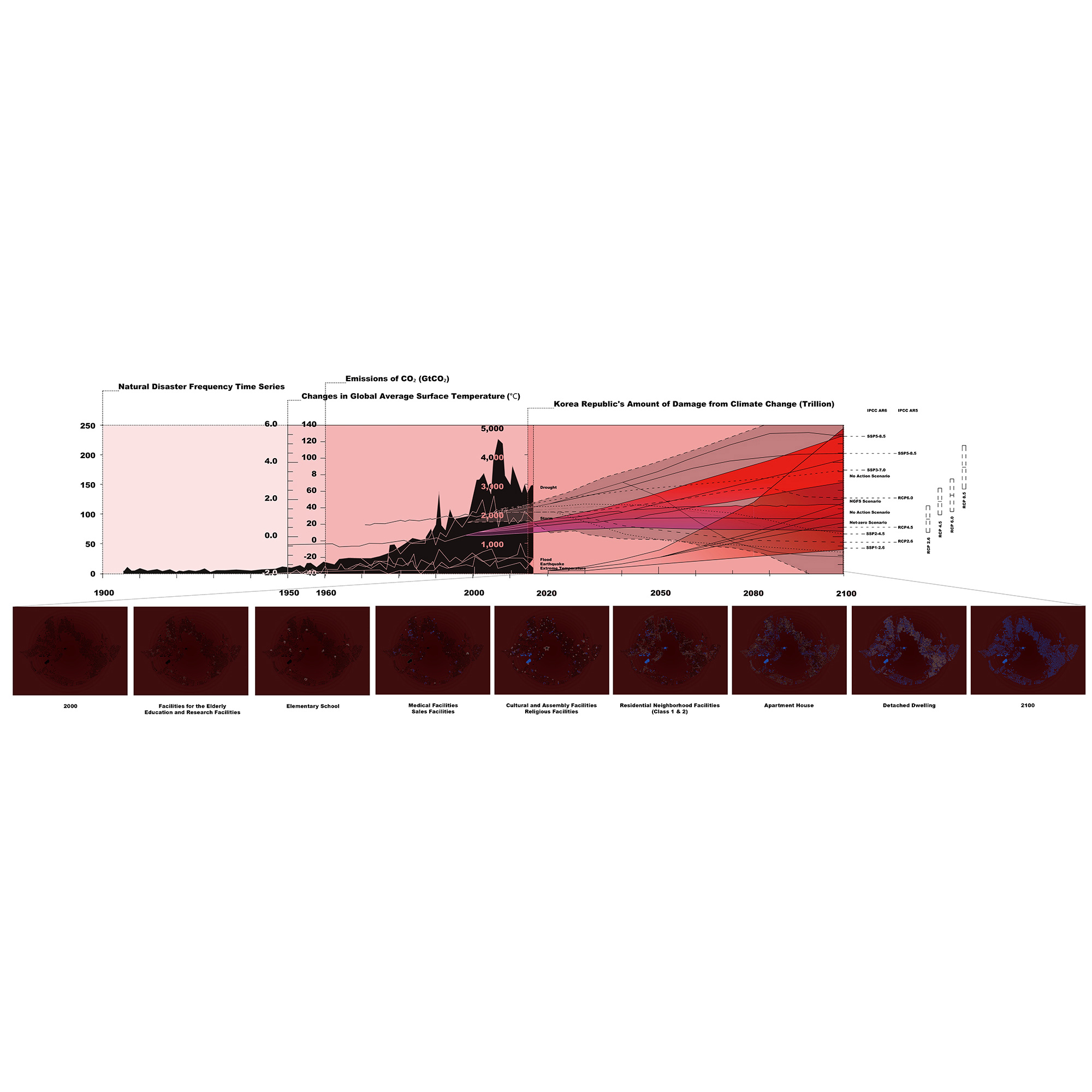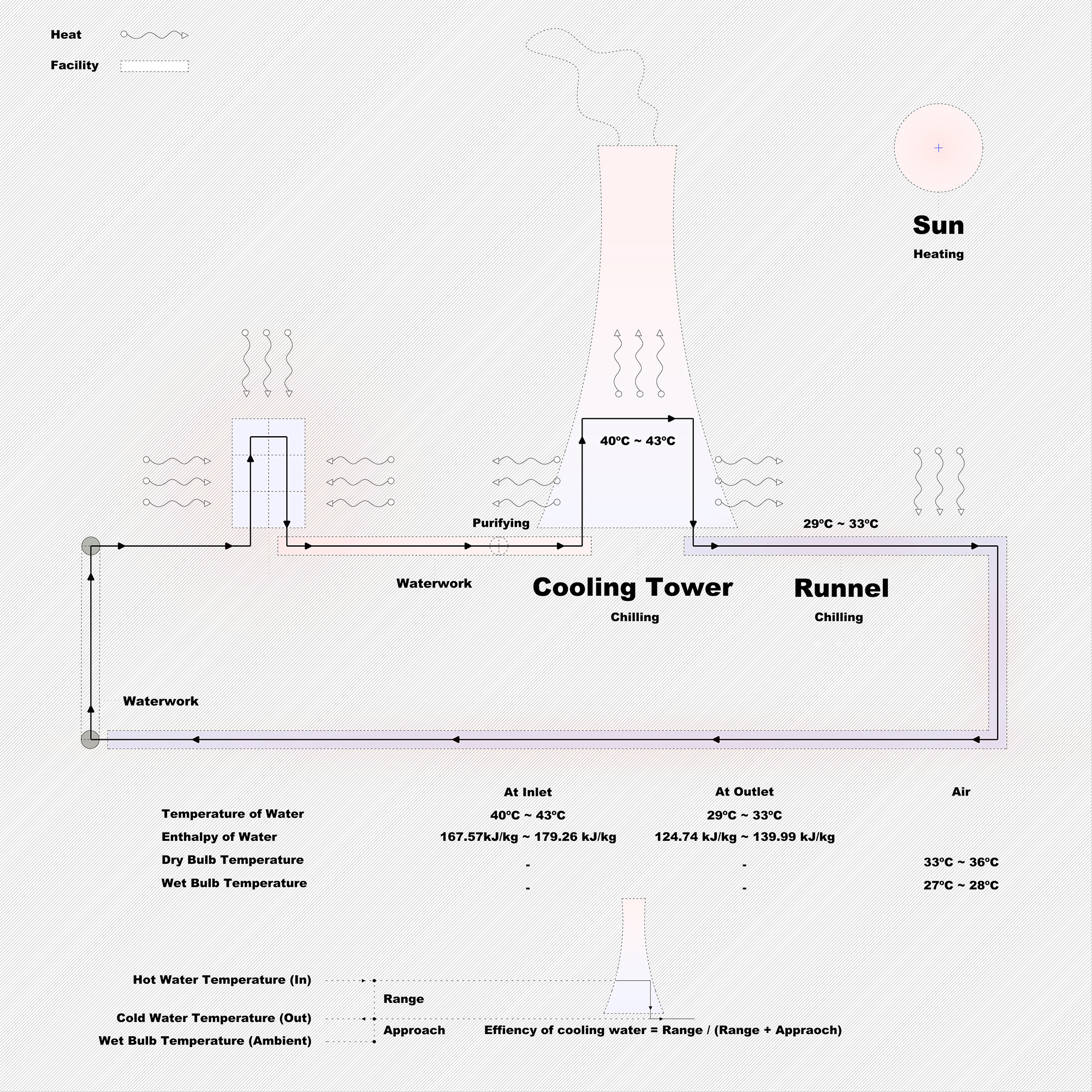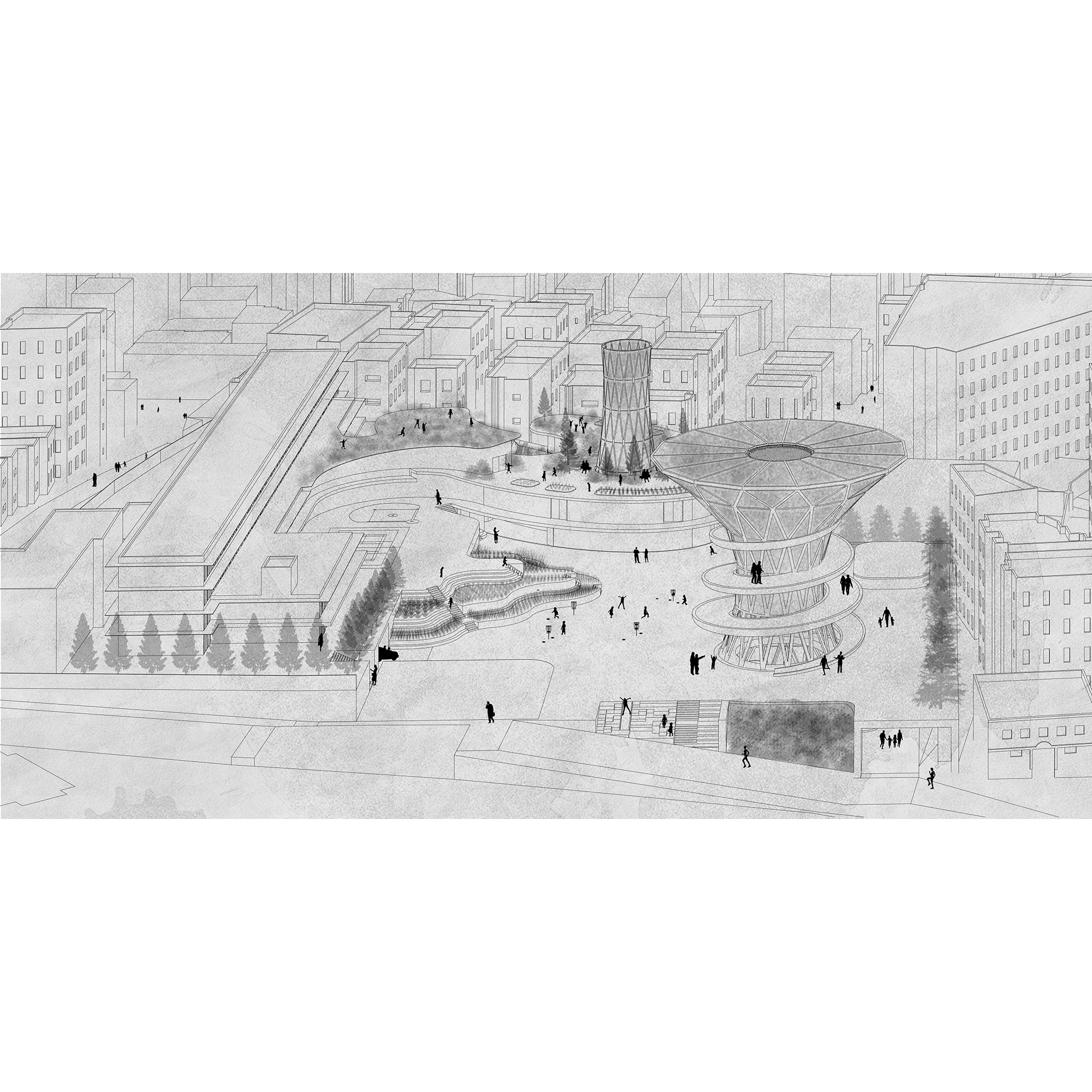강해성
Kang Haeseong
‘다문화 도시에 나타나는 시민사회의 문제점에는 타자인 사람들에게 공감을 일으키지 못한다는 도덕적 어려움이 도사리고 있다. 그리고 나는 육체의 고통이 왜 이를 인정하고 그 초월적 기원을 가시화하는 장소를 필요로 하는지 이해함으로써 그런 공감이 일어난다고 믿는다. … 고통을 받아들이는 육체는 시민적 육체가 될 준비가 되어 있다. 이 시민적 육체는 다른 사람의 고통, 거리에 함께 현존하는 고통, 끝내 견딜 수 있는 그 고통에 민감하다. 비록 다양한 세상에서 각자가 자신이 무엇을 느끼는지, 자기 자신이 누구인지를 타인에게 설명하지 못하더라도 말이다.’
— 리처드 세넷, 『살과 돌』
‘열’은 인류로 비유되는 살이 도시문명인 돌을 경험하는 매개이자 그 경험에 가장 크게 영향을 주는 요인이자, 육체에 고통으로 작동하기도 하는 하나의 요인이다. 기후변화는 열을 증폭시키며, 본 프로젝트에서 명명한 새로운 주체인 ‘기후유목민’을 만들었다. 기후유목민은 기후변화로 인해 거주지를 옮기지는 않지만 도시를 떠돌게 된 이들을 일컫는다. 기후유목민을 위한 쉼터가 임시로 지정되며 발생하는 현상은 우리의 도시에 열과 악천후로부터 안식을 취할 장소, 즉 기후유목의 장소가 부족함을 알려준다.
기후변화의 시나리오에서 예견하듯 점차 악화될 도시의 기후로 인해, 도시에서 기상현상에 대응하기 위한 시설들은 가까운 미래에 그 기능이 더욱 증폭되어 도시 곳곳에 나타날 것이다. 그리고 다리 밑의 그늘과 같이, 기반시설이 나타나며 발생하는 부산물로서 기후유목민들이 머무를 수 있는 공적 영역이 발생할 것이다. 이를 위해서는 기후변화에 대응하기 위한 시계열이 필요하며, 본 프로젝트는 그에 가장 먼저 대응할 시설을 제안한다.
더 많은 열을 품을 수 밖에 없는 운명인 미래의 도시는 그 열을 해소할 시설이 필요하다. 열을 해소하기 위해 인류가 가장 공들여 지은 시설은 ‘냉각탑’이다. 냉각탑은 열을 흡수한 물이 냉각탑 내부로 분무되고 냉각탑 하부로부터 상승하는 공기에 의해 식혀져 다시 배출되는 곳이다. 냉각탑은 도시화되기 위해서 변형된다. ‘변형된 냉각탑’은 경사지에서 지형적 이점을 취할 수 있다. 연돌효과를 이용한 공기의 유입에서 경사지형의 지하는 쾌적한 온도를 갖는 바람이 부는 영역이 될 수 있기 때문이다. 작은 조직들이 밀집한 저층주거지에서 큰 블록을 차지하는 공공의 시설들의 공터는 그 인근의 길들과 지표고도에서 큰 차이를 갖게 된다는 점에서 기회의 땅이다. 공터의 지하와 지상이 주변의 조직으로 열리면 거대한 블록이 가로막고 있던 서로 다른 조직 간의 접점이 나타난다. 지하는 적극적으로 트이고, 지상에서는 물리적인 경계들을 이용해 영역을 나누며 연결한다.
그리고 우리나라의 많은 공공의 시설들이 갖고 있던 천편일률적인 배치 - 일자의 건물과 거대한 공터 - 에 들어서며, 장소의 물리적 변화의 씨앗으로 작동한다. 공공의 시설들이 갖고 있던 전형적인 배치와 비어있는 땅은 시민적 공간이라고 하기엔 하나의 거대한 이벤트에 걸맞고, 사용자들에 대한 강한 통제력을 갖는 공터이다. 이들은 변형된 냉각탑과 이를 시설과 연결하는 짧은 띠들로 인해 해체되고 재조합된다. 짧은 띠들은 거대한 공터를 분절하며 다양한 성격의 공간을 만든다. 기존 시설의 프로그램이 연장되고, 새로운 집단을 받아들일 수 있는 가능성을 갖게 된다. 본 프로젝트에서 조명한 초등학교에서는 초등학생, 영유아의 교육, 평생교육의 학습자, 그리고 시민들이 해당한다. 새로운 유목의 장소는 근린주구 단위로 형성되며, 경사지의 고원처럼 존재하던 장소에 평원을 만들어준다. 시민적 육체들은 유목의 장소에서 그들의 육체적 수동성에서 벗어날 가능성을 갖게 된다.
There is a moral difficulty that civil society's problems in multicultural cities do not resonate with others. And I believe that empathy occurs by understanding why physical pain requires a place to acknowledge it and visualize its transcendent origin. ··· The body that accepts pain is ready to become a civil body. This civil body is sensitive to the pain of others, the pain that exists together in the streets, and the pain that can be endured eventually. Even if each person in various worlds cannot explain to others what they feel or who they are.’
- Richard Sennett, 『Flesh and Stone』
Heat is the medium through which human beings experience the stone of urban civilization and the most influential factor in their experience. It is also a factor that works as pain in the body. Climate change amplifies heat and creates a new subject named 'Climate Nomads' in this project. Climate nomads refer to people who do not move their residences due to climate change but have wandered through cities. Temporary designation of shelters for climate nomads and what happens tells us that our cities lack places to rest from heat and severe weather, i.e., places for climate nomads.
As predicted in the climate change scenario, due to the increasingly deteriorating urban climate, facilities to respond to weather events in cities will be further amplified and appear throughout the city in the near future. And as a byproduct of the emergence of infrastructure, such as the shadow under the bridge, there will be public areas where climate nomads can stay. This requires a time series to cope with climate change, and this project proposes a facility to respond first.
The future city, destined to embrace more heat, needs facilities to relieve it. The most elaborate facility built by mankind to relieve the heat is the "cooling tower." The cooling tower is a place where heat-absorbing water is sprayed into the cooling tower, cooled by air rising from the lower part of the cooling tower, and discharged again. The cooling tower is deformed to be urbanized. The 'modified cooling tower' can take topographical advantage on slopes. This is because in the inflow of air using the cartilage effect, the underground of the slope may be a windy area with a pleasant temperature. The vacant lot of public facilities, which occupy large blocks in low-rise dwellings where small organizations are concentrated, is a land of opportunity in that it makes a big difference in the roads and surface altitude near it. When the underground and ground of the vacant lot are opened to surrounding tissues, a contact point between different organizations that were blocked by a huge block appears. The basement is actively open, and on the ground, physical boundaries are used to divide and connect areas.
And entering the uniform layout of many public facilities in our country - a one-size-fits-all building and a huge vacant lot - works as a seed of physical change in the place. The typical layout and empty land held by public facilities are suitable for one huge event to be called a civil space, and is an open space with strong control over users. They are dismantled and recombined by modified cooling towers and short bands connecting them to the facility. The short bands divide the huge open space and create spaces of various characteristics. Programs in existing facilities are extended, and there is a possibility of accepting new groups. Elementary schools illuminated in this project include elementary school students, education for infants and toddlers, learners of lifelong education, and citizens. The new nomadic place is formed in units of neighborhoods and creates a plain in a place that existed like a plateau on a slope. Civil bodies have the potential to escape their physical passivity in nomadic places.
